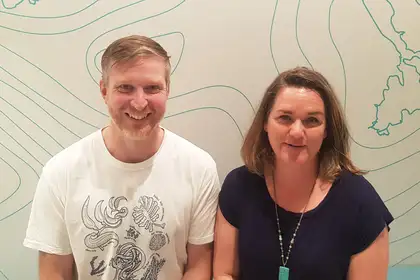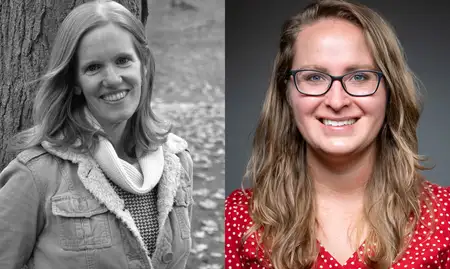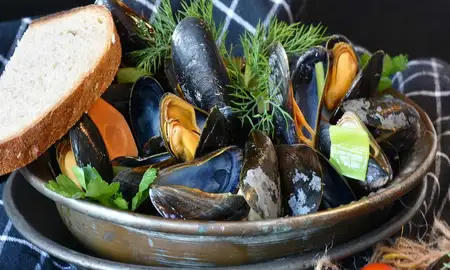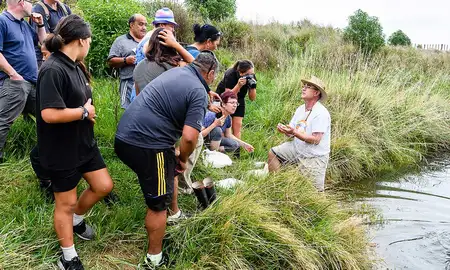
Mr Thomas Nash and Associate Professor Kelly Dombroski.
The book, A Field Guide to Wellington Transitions, will bring together interviews with the people behind 30 or more transformative transition programmes already underway in the greater Wellington region.
Associate Professor Kelly Dombroski says, “The framework we're using looks at six different transitions that need to happen by 2040 to adapt to climate change and respond to environmental crises and social crises."
“There's a lot of very smart, dedicated and caring people working on these already, and our idea was to pull them all together into a single book and showcase the possibilities for transition.”
The six areas in question are transport, community, economy, energy, environment and housing. Interviewees to date have included Newtown-based Kaicycle, dedicated to recycling organic waste and urban farming, the Mevo car-sharing service, the not-for-profit electricity supplier Toast Electric, the Te Hiko Centre for Community Innovation and the Wellington Sustainability Trust.
The research is being shared between Dr Dombroski, Dr Gradon Diprose of Manaaki Whenua - Landcare Research, Associate Professor Amanda Yates, Ngāti Rangiwewehi, Ngāti Whakaue, Te Aitanga a Māhaki, Rongowhakaata, from Auckland University of Technology and Wellington Regional Councillor Mr Thomas Nash in his role as Social Entrepreneur in Residence at Massey University.
“We all have connections to Wellington and we love it, so it's nice to do something on a place that you genuinely care for and want to see do well,” Dr Dombroski says.
“We're planning to complete all the writing by March next year. We’re keen to share it as a resource so we’ll be using our research grant from Building Better Homes, Towns and Cities National Science Challenge to pay for publication costs. Then we’ll just mail it out.”
Established in 2014 under the Ministry of Business, Innovation and Employment, the National Science Challenges (of which there are 11 in total) aim to tackle the biggest science-based issues and opportunities facing Aotearoa New Zealand.
The goal of Building Better Homes, Towns and Cities is to create homes, neighbourhoods and cities that enrich people's lives, allowing them to reach their social, cultural and economic potential.
“It’s actually really fun to do this project because everyone we talk to is interesting. They’ve really thought about what they’re doing and really care about it. When we come away from interviews, everyone's kind of quite giddy," Dr Dombroski says.
Mr Nash agrees.
“Yeah, it’s a really good buzz. What I like about the initiatives and projects and businesses that we're interviewing is that they are doing good just by existing. The good they are doing is not an added bonus, it’s baked into their work. For example, we met FTN Motion who’re making the Streetdog urban electric motorcycle. They’re just a cool young business solving a problem and every bike they sell helps reduce emissions," he says.
“They haven't led their marketing with the environment angle. They've led with a great product that looks cool and works super well.”
The 2040 timeframe for the Wellington transition was chosen because it's far enough away for existing projects to be fully realised and close enough to work towards in a meaningful way.
“I think 2040 is a good milestone to look towards. By 2040 I expect that there'll be way more people here," Mr Nash says.
He believes Wellington will need to build a lot more housing and supporting transport infrastructure, while at the same time protecting its natural infrastructure by restoring wetlands, native vegetation, forests, streams and rivers.
“Those are the things that will sustain life in longer term.”
Dr Dombroski cites her colleague Dr Amanda Yates’ work on the city’s interconnectivity with the living world – its inner force, or mauri.
“We’re looking at how we enhance the mauri of the city in each of the six transition areas in a holistic way. We’re not trying to separate them out, because housing relates to energy, relates to transport, relates to economy, you know. They're never separate. A lot of the aspects of that transition are already happening.”
Mr Nash concurs.
“We know that we're not on track right now as a region or as a country to reach our target states on emissions reduction, on freshwater quality, on renewable energy, on community health and wellbeing and so forth. We want to show how we can close the gap.”
He says the book is designed to be hopeful.
“We're saying it can be done. It is being done. So do more of this, and we will reach those target states that we've set for ourselves and that we know we need to reach.”
The authors are keen to hear of any projects that might be a good fit for the book. If you know of any, contact them here.
Related news
National Science Challenge grant supports sustainable land use research
Research project aims to spark conversation and encourage collaboration between people and groups with different ideas about how land and water should be used.

Greenshell mussels beneficial in the fight against osteoarthritis
New research shows eating NZ Greenshell mussels may help in combatting early stages of osteoarthritis, one of the leading causes of disability in older adults.

Improving water quality in King Country key aim for Massey professors
Professor Russell Death and Professor Ian Fuller have been granted $50,000 from the Our Land and Water National Science Challenge.
